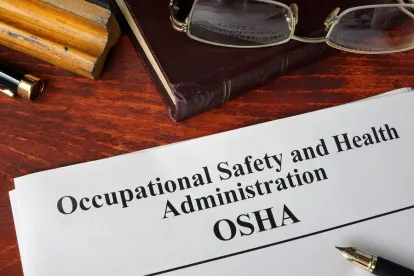Fifteen months after the COVID-19 pandemic began, the Occupational Safety and Health Administration (OSHA) has promulgated an Emergency Temporary Standard (ETS) for healthcare employers. OSHA has published voluntary guidance for other industries.
OSHA is fulfilling an obligation pursuant to an Executive Order issued by President Joe Biden in January to promulgate an ETS. President Biden set a March 15, 2021, deadline to move on such a standard, but the agency experienced major delays due in large part to a changing landscape as vaccinations became common and the Centers for Disease Control and Prevention (CDC) loosened face covering and physical distancing requirements for fully vaccinated individuals.
The ETS does not apply to other industries more significantly affected by the virus, such as meatpackers, poultry producers, manufacturers, and construction. It will be effective upon publication in the Federal Register.
The ETS targets healthcare settings where COVID-19 patients are treated. It exempts fully vaccinated employees from wearing a mask, social distancing, and barrier requirements when the employer determines there is no reasonable expectation another person with suspected or confirmed COVID-19 would be present. It is unclear how this determination can be made, however.
Standards Affected
The ETS is a new standard added to the General Industry standards at 29 CFR § 1910.500 et seq. as a new Subpart U. It includes multiple sections:
-
1910.502 provides that the ETS applies to all settings where any employee provides healthcare services or healthcare support services.
-
1910.504 addresses limited requirements for situations where respirators are used in accordance with specific provisions in 1910.502.
-
1910.505 provides that each section of Subpart U and each provision within those sections is separate and severable from the other sections and provisions.
-
1910.509 contains materials adopted as part of the ETS, including CDC guidance, consensus standards for personal protective equipment (PPE) and EPA’s list of approved disinfectants.
14 Days or 30 Days to Comply
Once effective, covered employers must comply with most of the provisions within 14 days, but they will have 30 days to comply with the provisions involving physical barriers, ventilation, and training.
Written Plans
Covered employers with more than 10 employees will be required to develop and implement written COVID-19 plans. The key requirements of the written plans are:
-
Assigning a designated safety coordinator with authority to ensure compliance, a workplace-specific hazard assessment, involvement of non-managerial employees in hazard assessment and plan development/implementation, and policies and procedures to minimize the risk of transmission of COVID-19 to employees.
-
Patient screening and management, including limiting and monitoring points of entry to settings where direct patient care is provided; screen and triage patients, clients, and other visitors and nonemployees; and implement patient management strategies.
-
Developing and implementing policies and procedures to adhere to Standard and Transmission-Based precautions based on CDC guidelines.
-
PPE requirements, including providing and ensuring each employee wears a facemask when indoors and when occupying a vehicle with other people for work purposes; and providing and ensuring employees use respirators and other PPE for exposure to people with suspected or confirmed COVID-19 and for aerosol-generating procedures on a person with suspected or confirmed COVID-19.
-
Limiting employees present for aerosol-generating procedures on persons with suspected or confirmed COVID-19 to only those who are essential; performing aerosolizing procedures in an airborne infection isolation room, if available; and cleaning and disinfecting surfaces and equipment after aerosolizing procedures are completed.
-
Keeping people physically distant, at least six feet apart, when indoors.
-
Installing cleanable or disposable solid barriers at each fixed work location in non-patient care areas where employees are not separated from other people by at least six feet.
-
Following standard practices for cleaning and disinfection of surfaces and equipment in accordance with CDC guidelines in patient care areas, resident rooms, and for medical devices and equipment; in all other areas, clean high-touch surfaces and equipment at least once a day, and provide alcohol-based hand rub that is at least 60 percent alcohol or provide readily accessible handwashing facilities.
-
Ensuring that employer-owned or controlled existing HVAC systems are used in accordance with manufacturer’s instructions and design specifications for the systems and that air filters are rated Minimum Efficiency Reporting Value (MERV) 13 or higher if the system allows it.
-
Health screening and medical management, including:
-
Screening employees before each workday and shift;
-
Requiring each employee to promptly notify the employer when the employee is COVID-19 positive, suspected of having COVID-19, or experiencing certain symptoms;
-
Notifying certain employees within 24 hours when a person who has been in the workplace is COVID-19 positive;
-
Following requirements for removing employees from the workplace;
-
For employers with more than 10 employees, providing medical removal protection benefits in accordance with the standard to workers who must isolate or quarantine.
-
Providing reasonable time and paid leave for vaccinations and vaccine side effects.
-
Ensuring all employees receive training so they comprehend COVID-19 transmission, tasks, and situations in the workplace that could result in infection, and relevant policies and procedures.
-
Informing employees of their rights to the protections required by the standard and do not discharge or in any manner discriminate against employees for exercising their rights under the ETS or for engaging in actions required by the standard.
-
Establishing a COVID-19 log (if more than 10 employees) of all employee instances of COVID-19 without regard to occupational exposure and following requirements for making records available to employees/representatives.
-
Reporting work-related COVID-19 fatalities and in-patient hospitalizations to OSHA.
All requirements must be implemented at no cost to employees.
State Plan States
It is unclear what effect the ETS will have on requirements for healthcare employers in the four OSHA “State Plan” states that have enacted their own COVID-19 standards under their authority pursuant to the Occupational Safety and Health Act. These are California, Michigan, Oregon, and Virginia. State Plan states must enact standards and run programs that are “at least as effective as” OSHA’s. Healthcare employers also will need to be aware of the myriad state and local requirements relating to COVID-19 in healthcare settings.




 />i
/>i

